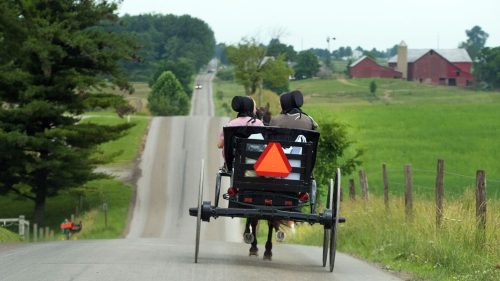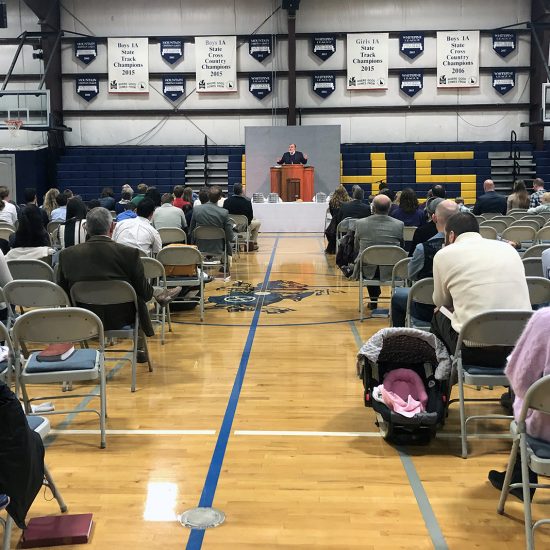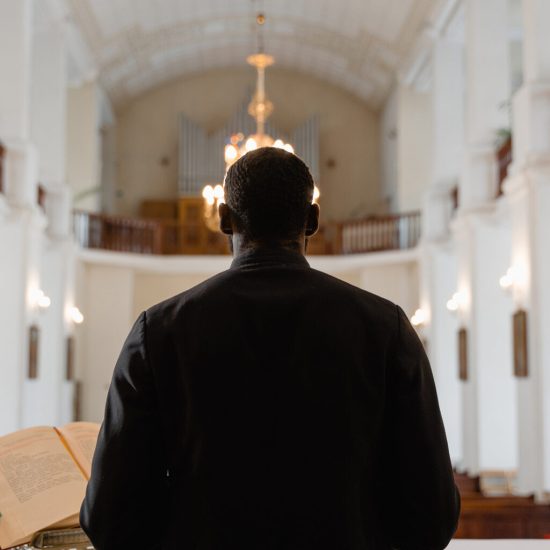
(RNS) — In bodycam footage from an April 2023 traffic stop in rural Ohio, an unseen law enforcement officer approaches a spartan black buggy, typical of vehicles used by the Swartzentruber Amish, and asks the two young men inside if they’ve ever received a ticket.
“I think I’m going to tow your buggy, unless you got a light in there,” the cop says.

(Photo by Randy Fath/Unsplash/Creative Commons)
The driver, a young man named Ure Gingerich, looks perplexed, then defiant. “Tow it if you want it!” Later, he reminds the officer that he could fight back, but it’s against his faith. “I’m not getting a lawyer, but I’m just telling you that I could.”
The scene has become a common one in a handful of counties dotted around central and eastern Ohio, which is home to a significant population of Swartzentrubers — the most conservative sect of the Amish — who’ve found themselves running afoul of a new law that mandates all buggies be affixed with a flashing amber LED light for visibility. While the state claims the new measures are crucial for safety, the Swartzentrubers and other conservative Amish groups say it unfairly infringes on their right to freedom of religion. And though the Amish generally shy away from litigation, help for the Ohio Swartzentrubers has come from an unlikely place: Harvard University Law School.
On Tuesday (Aug. 20), lawyers and students affiliated with Harvard University’s Religious Freedom Clinic, along with Ohio-based counsel Taft Stettinius & Hollister, filed a complaint in Hardin County and moved for a preliminary injunction that would immediately halt enforcement of the law statewide. They argue the law violates numerous constitutional rights, including that it prevents the Swartzentrubers from freely practicing their faith and unduly restricts their ability to move throughout the state.

(Photo by Joshua J. Cotten/Unsplash/Creative Commons)
Originally introduced as House Bill 30 in 2021 by Republicans Darrell Kick and Scott Wiggam and signed into law in the summer of 2022, the new rule was expected to cut down on accidents involving buggies and cars in areas where the Amish, who eschew driving and car ownership, and the mainstream “English” live side by side. State-collected data published in 2020 says there were between 60 and 84 such crashes per year from 2009 to 2019; fatalities were becoming more common, rising from six between 2009 and 2015 to nine from 2016-2019. Because buggies can be made of metal, fiberglass, and wood, those inside often fare worse than those inside the cars.
But the Swartzentruber community, roughly 12% of the state’s Amish population, has broadly refused to comply. It sees the lights as frivolous adornments, which goes against the sect’s religious commitment to simplicity. Members are also wary of deviating from tradition, according to the Bible’s mandate to honor one’s forefathers.
In a response to an earlier, failed attempt by Ohio to mandate flashing lights in 2020, Abe Mast, a member of another conservative sect known as the Kenton Amish, submitted testimony to the House’s Transportation and Public Safety Committee in which he argued his community was being scapegoated. “We feel the greatest cause of accidents is the use and influence of drugs and alcohol and the cell phone used while driving,” Mast wrote.
And in a bill analysis published at the time, the state noted a potential First Amendment issue and cited a similar case in Wisconsin, which ruled in favor of the Amish opposition.
Over the years, similar laws mandating emblems — such as fluorescent yellow triangles — for slow-moving vehicles have passed in Michigan, Wisconsin, Minnesota, Pennsylvania, and Kentucky. In all of these cases, the law eventually changed to accommodate the Swartzentrubers, who found culturally acceptable workarounds, including lantern style lights or patches of gray reflective tape.
Politicians were aware there would again be potential opposition. The Ohio legislators who introduced the House Bill 30 took pains to show they had secured Amish support, most notably by submitting a handful of letters from members of the Amish community who were in favor, two of which were authored by Swartzentrubers. (None of the letters are signed.)
Since this law went into effect, there have been allegations of law enforcement going out of its way to target Swartzentruber drivers. Swartzentrubers have been ticketed on their way home from court; cops have waited outside church services on Sunday, to nab as many departing drivers as possible. In one case, a couple with children in their buggy was rear-ended by a motorist and written up for child endangerment, a charge that comes with potential jail time.

(Photo by Randy Fath/Unsplash/Creative Commons)
Men who have been ticketed repeatedly have refused to pay fines and been dragged back to court, much to the irritation of all parties involved. They’ve expressed their theological issues with the law, but always out of context or too late. “You can’t come into court in November, plead no contest, fail to raise the constitutional issue, get found guilty, get sentenced, and wait six months later and then say, ‘Hey, I want this dismissed because it’s unconstitutional,’” Judge John Good of Ashland County told Swartzentruber defendants in May of 2023.
The Amish have “zero concept” of the court system, said Cory Anderson, a sociologist based in Holmes County who has been communicating with the Swartzentruber community on this issue and is now aiding in Harvard’s case. While being overly litigious is frowned upon, the Amish can defend themselves provided certain stipulations are met, according to Anderson, who studies Conservative Anabaptists, including the Amish.
“They will not directly ask for attorneys to represent them, and they will not pay attorneys because they believe in being ‘defenseless Christians,’” said Anderson, a Plain Mennonite, which shares many theological and cultural similarities with the Amish.
Often when the Amish receive legal help, it is because someone outside the community offers it, as in the famous case of Wisconsin v. Yoder, in which a group of academics, lawyers, and civil rights activists banded together to argue that Amish children should be exempt from higher education. (The Supreme Court sided with the Amish in 1972.) The American Civil Liberties Union provided legal assistance in other Swartzentruber buggy cases.
This time, Anderson put out feelers to different firms, trying to figure out who might step in. A game of legal telephone ensued, until eventually news of the Swartzentrubers’ predicament reached Harvard.
The Harvard Law School’s Religious Freedom Clinic was founded in 2020, part of a wave of similar outfits at prestigious institutions, including Stanford, Yale, and Notre Dame. The clinic worked on a lawsuit brought by a Lakota family in Nebraska whose children’s hair was forcibly cut by school staff, as well as the case of John Henry Ramirez, a Texas death row inmate who wanted dispensation to have his pastor pray with and touch him during his execution.
Steven Burnett, a fellow at the Religious Freedom Clinic, said the legal precedents from other states bode well for the Swartzentrubers. “It’s the same kind of tension between a presumed safety interest and a religious interest,” he said, elaborating that the idea of safety “hangs over” a lot of religious liberty cases Harvard handles. But a close look at the data, he said, shows that equating visibility with reduced accidents is simplistic. Crashes involving buggies and cars occur “by a large margin” during the day, he said, in good weather conditions and on straight roads, often when a car sees a buggy and attempts unsuccessfully to pass it.
The Harvard students and faculty working on the case have developed a good rapport with their clients, whom they’ve traveled multiple times to meet, according to Burnett. Though the Amish can be reserved and taciturn — their faith encourages them to speak minimally and carefully — Burnett said they were “very warm, very welcoming,” even cooking a large meal for their visitors. “They don’t show their gratitude in normal, mainstream American ways,” he said, “but I’ve never gotten the sense that they weren’t grateful.”
Burnett chalks up Ohio’s initial skepticism to the Swartzentrubers’ claims to assumptions that the Amish are monolithic. “They assume because certain Amish people comply with the safety regulations, the other Amish who refuse to comply are doing it for some disingenuous or nonreligious reason,” he said. But by visiting Swartzentruber homes, which feature no electricity or plumbing, the students saw firsthand how strong their clients’ low-tech inclinations were. “They explained their beliefs coherently and sincerely.”
Burnett says Harvard’s approach seeks the widest amount of relief the fastest — as opposed to dealing with each of the hundreds of citations individually — but depending on the judges’ interpretations, it could take years for the Swartzentrubers and other conservative Amish people to get a final verdict.
“I think a lot of judges think, if I grant this then someone dies in a car accident or a buggy crash, then that would be on me,” he said. “But people are a bit too quick to let the idea of safety dominate over our various rights.”
This story has been updated to clarify Anderson’s communication with the Swartzentrubers has been informal.






